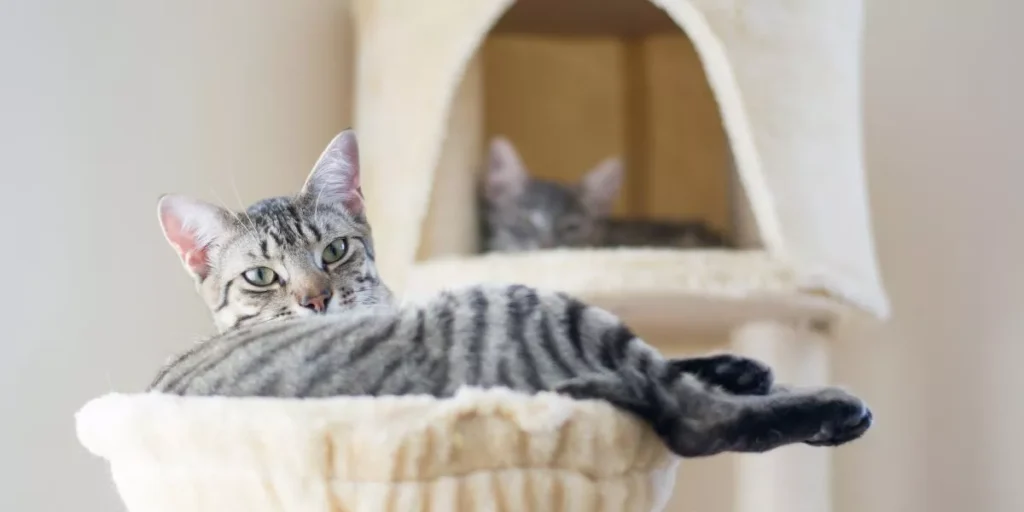The Science Behind Cat Furniture Design

When it comes to designing furniture for your feline companions, have you ever considered the intricate science behind it? Understanding the nuances of cat behavior and how they interact with their environment can truly revolutionize the way we perceive cat furniture. By delving into the depths of feline instincts and preferences, designers unlock a world where form and function harmonize to create spaces that cater to every whisker’s need. So, next time you see a cat tree or scratching post, remember there’s more than meets the eye in the realm of cat furniture design.
Feline Behavior and Preferences
Understanding how cats behave and what they prefer is crucial in designing cat furniture that they’ll enjoy and use regularly. Cats are natural climbers and love to perch up high to observe their surroundings. Providing tall cat trees with platforms and perches satisfies this instinct and gives them a sense of security.
Scratching is another essential behavior for cats, as it helps them stretch their muscles and mark their territory. Including sturdy scratching posts or pads in your cat furniture design will prevent them from damaging your belongings.
Cats also enjoy cozy hiding spots where they can retreat and feel safe. Incorporating enclosed spaces like cat caves or tunnels in your furniture will cater to this preference. Additionally, felines love to play and explore, so adding interactive elements like dangling toys or tunnels can keep them entertained and mentally stimulated.
Impact of Environmental Enrichment
To enhance your cat’s environment and well-being, consider the impact of incorporating environmental enrichment elements in their living space. Environmental enrichment plays a crucial role in keeping your feline friend happy and healthy. By providing opportunities for mental stimulation and physical activity, you can prevent boredom and behavioral issues in your cat.
Elements such as vertical spaces like cat trees or shelves allow your cat to climb and perch, mimicking their natural instincts. Interactive toys and puzzle feeders engage your cat’s mind and provide a source of entertainment. Window perches offer a vantage point for your cat to observe the outside world, satisfying their curiosity.
Scratching posts and pads fulfill your cat’s need to scratch while also helping to keep their claws healthy. Overall, incorporating environmental enrichment elements in your cat’s living space can lead to a more content and fulfilled feline companion.
Ergonomics in Cat Furniture Design
Incorporate ergonomic principles into your cat furniture design to ensure comfort and functionality for your feline friend. When designing cat furniture, consider the size and shape of the furniture to accommodate your cat’s natural movements. Opt for materials that offer both durability and a comfortable texture for your cat to lounge on.
Ensure that the height of perches or platforms allows your cat to easily access them without straining. Cats enjoy being up high, so providing elevated spaces can satisfy their natural instinct to perch and observe their surroundings. Additionally, integrating scratching posts at appropriate heights and angles can promote healthy scratching behaviors and prevent furniture damage.
When designing hideaways or enclosed spaces, make sure they’re spacious enough for your cat to enter, turn around, and lay down comfortably. Cats seek out cozy and secure spots for rest and relaxation. By incorporating ergonomic considerations into your cat furniture design, you can create a comfortable and functional environment that meets your feline companion’s needs.
Understanding Natural Instincts
Consider the innate behaviors and instincts of your feline companion when designing cat furniture to cater to their natural preferences and needs. Cats have a strong desire to climb and perch up high to observe their surroundings. Providing tall cat trees or shelves can fulfill this instinct, offering them a sense of security and territory.
Scratching is another natural behavior for cats to mark their territory and keep their claws healthy. Including scratching posts or pads in your cat furniture design can prevent damage to your home and satisfy this instinctual need.
Cats also enjoy hiding and seeking out cozy, enclosed spaces for napping or feeling safe. Incorporating cat caves or enclosed beds can give them a private sanctuary.
Lastly, cats are obligate carnivores, so incorporating elements that encourage physical activity, like interactive toys or climbing structures, can mimic their natural hunting instincts and keep them mentally and physically stimulated. Understanding these natural instincts will help create a cat-friendly environment that meets your feline friend’s needs.
Enhancing Cat Well-being
Enhance your cat’s well-being by prioritizing their physical and mental health through thoughtful cat furniture design. Providing furniture that encourages exercise, such as cat trees with different levels for climbing and scratching posts for stretching, helps keep your cat active and agile. Interactive furniture like puzzle feeders can stimulate their minds and prevent boredom, leading to a happier and healthier pet.
Incorporating cozy and safe spaces into your cat’s furniture design, such as enclosed beds or hiding spots, gives them a sense of security and privacy. Cats often seek out elevated spots to observe their surroundings, so including perches or window shelves can fulfill their natural desire to survey their environment comfortably. Additionally, utilizing materials like natural wood or soft fabrics can provide comfort and warmth, promoting relaxation and reducing stress.
Trending Products










